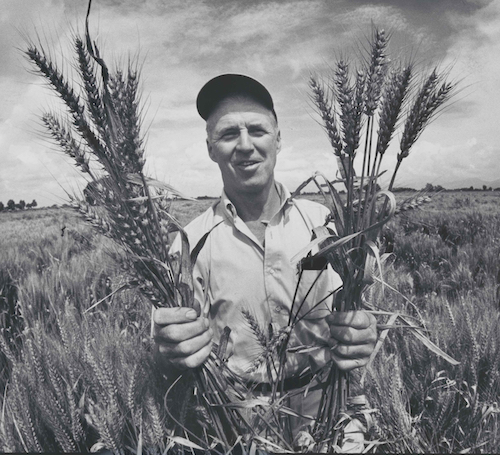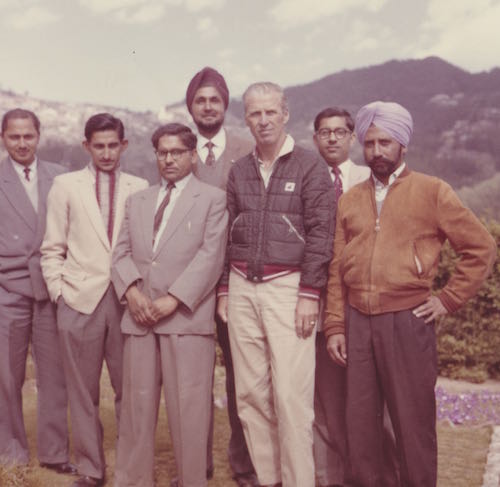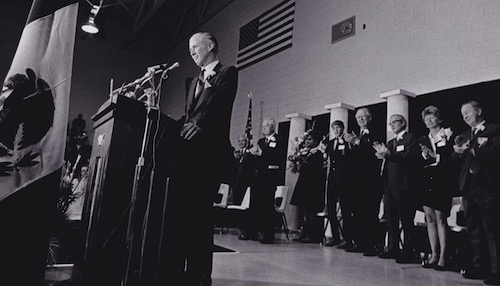Communiqué
The 1970 Nobel Prize winner was “The Man Who Tried to Feed the World” on AMERICAN EXPERIENCE, Wednesday, Dec. 21 at 10 pm
< < Back toAmerican Experience The Man Who Tried to Feed the World
New Documentary About Norman Borlaug, the Nobel Prize Winner Whose “Green Revolution” Transformed the World
The Man Who Tried to Feed the World tells the story of Norman Borlaug, an American agronomist who won the 1970 Nobel Peace Prize for his efforts in fighting global hunger. By increasing the world’s food supply, Borlaug made it possible for the planet to support far more people than had been thought possible, saving countless lives in the process. But in doing so, he unleashed a series of unintended consequences that tarnished his reputation and forever changed the environmental and economic balance of the world. Written, directed and produced by Rob Rapley and executive produced by Mark Samels and Susan Bellows.

Born in 1914, Norman Borlaug grew up on an isolated Iowa farm, working from dawn until sunset, using methods that would have been familiar to the ancient Romans. But farm life was revolutionized in the mid-1920s when Henry Ford’s tractor became widely available, drastically reducing the amount of labor needed to plant and harvest crops. The new technology made it possible for Borlaug to leave the family farm and attend college.
In 1944 Borlaug — now armed with a Ph.D. in plant pathology — was recruited for a Rockefeller Foundation program designed to bring stability and prosperity to rural farmers in Mexico. The goal was to defeat stem rust, a disease that had plagued humankind for thousands of years and was now decimating Mexico’s wheat crop year after year. Once in Mexico, Borlaug encountered the horror of real malnutrition for the first time, and he soon recast his mission. Rather than help peasant farmers in their struggles with nature, he decided to fight hunger directly by developing a radically new kind of wheat: disease-resistant, adaptable, and incredibly productive.
Borlaug meticulously planted, cataloged, and pollinated thousands of wheat varieties, finally developing an all-purpose plant that could revolutionize a country’s food production. But there was a catch: Borlaug’s new wheat required massive amounts of costly fertilizer and water — an expense far beyond the means of most peasant farmers.
In 1949, the Communist Revolution in China brought new relevance to Borlaug’s research. Driven by the fear that discontented peasants around the world might tilt the Cold War in the Soviets’ favor, American policymakers made global food supply an urgent priority. The Rockefeller Foundation, working closely with the State Department, understood the potential in Borlaug’s work in Mexico: the Cold War could be won by fighting famine, since “no one becomes a Communist on a full belly.” Borlaug was given a free hand to continue to develop new, even more productive varieties of wheat. Borlaug’s once-modest Mexico project was now seen as a chance for the salvation of the world.

In 1963 Borlaug accepted an invitation from M.S. Swaminathan, an Indian agricultural scientist wrestling with food supply problems in his own country. India’s chronic food shortages and an exploding population seemed to foreshadow a bleak future for the rest of the world. Borlaug and Swaminathan tried to convince the government to convert the Indian style of agriculture to high-yield wheat. But their program required massive investments and triggered deep-seated apprehensions about the social and ecological consequences.
In the spring of 1966, Borlaug came face-to-face with the enemy he had been fighting all his life: Indian children begged for scraps of bread and trucks circled the streets every morning, picking up corpses. His patience with the Indian government growing thin, he harshly chastised officials for holding back the funds needed to launch the program. Borlaug’s tirade coincided with a harsh new policy from President Lyndon Johnson, who cut off shipments of wheat to India at the height of a devastating drought. In these circumstances the Indian government had little choice but to adopt the high-yield wheat program. In 1968, the harvest was one and a half times larger than the previous record. It marked the beginning of a movement that would change the face of the world: the “Green Revolution” of global industrial agriculture programs. Two years later, Borlaug won the Nobel Peace Prize.
But by 1970, Borlaug’s “revolution” was becoming a global leviathan: a creature of the World Bank, the State Department, and agribusiness. While the program vastly increased the world’s food supply and reduced global hunger, it turned out to be a Faustian bargain.
Borlaug would spend the final decades of his life watching his methods and achievements come under increasing fire by a wide range of critics, who held him responsible for soil degradation, the reduction of the water table, the spread of toxic chemicals, and the destruction of rural society around the world. Says historian Tore Olsson: “It’s really impossible to understand the massive growth of the human population, to understand the urbanization of our species, and our tremendous, increasing ecological impact on the world unless we understand Norman Borlaug and the Green Revolution.”

About the Participants
Jeanie Borlaug is Norman Borlaug’s daughter.
Nick Cullather is a professor of history at Indiana University and author of The Hungry World: America’s Cold War Battle Against Poverty in Asia.
Prakash Kumar is associate professor of history and Asian studies at Penn State.
Charles C. Mann is a correspondent for The Atlantic, Science, and Wired, and the author of The Wizard and the Profit: Two Remarkable Scientists and Their Dueling Visions to Shape Tomorrow’s World, about Borlaug and William Vogt.
Tore Olsson is an associate professor of history at the University of Tennessee, Knoxville, and author of Agrarian Crossings: Reformers and the Remaking of the US and Mexican Countryside.
Raj Patel is an award-winning writer, activist and academic. He is a research professor in the Lyndon B. Johnson School of Public Affairs at the University of Texas, Austin, and a senior research associate at the Unit for the Humanities at Rhodes University. He is the author of Stuffed and Starved: The Hidden Battle for the World Food System.MJohn Perkins is the author of Geopolitics and the Green Revolution.
M. S. Swaminathan is an Indian geneticist and administrator who worked with Borlaug in the 1960s to convince the Indian government to grow high-yield wheat. He has been called the “Father of the Green Revolution” in India.
George Varughese was a student of Swaminathan’s at the Indian Agricultural Research Institute and was selected by Borlaug to join the program in Mexico.
Noel Vietmeyer is author of Our Daily Bread: The Essential Norman Borlaug.
About the Filmmakers
| Written and Directed by | ROB RAPLEY |
| Produced by | ROB RAPLEY
JAMILA WIGNOT |
| Edited by | MARK DUGAS
R.A. FEDDE |
| Original Music by | TOM PHILLIPS |
| Narrated by | MICHAEL MURPHY |

